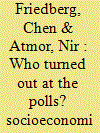| Srl | Item |
| 1 |
ID:
171686


|
|
|
|
|
| Summary/Abstract |
What drives a person to take part in a collective action and engage in political protest? This is a question that has long interested social scientists. Recent theoretical and empirical research in industrialised countries that centres on the political behaviour of individuals examines five main factors – grievances, efficacy, identity, emotions and social embeddedness – to understand what leads citizens to join social protests. Drawing on such research and using Israel National Election Studies (INES) data, this article examines the political attitudes of participants in the widespread ‘Social Justice’ protests that took place in Israel in 2011, with the aim of explaining what motivates civic participation in such protests. By analysing the profile of the demonstrators, our findings provide additional empirical evidence to the theoretical approach and assist in understanding political protest behaviour in general.
|
|
|
|
|
|
|
|
|
|
|
|
|
|
|
|
| 2 |
ID:
149184


|
|
|
|
|
| Summary/Abstract |
2015 was an important year in the history of Israeli general elections: voter turnout rose by 4.5% compared to the 2013 elections, exceeding the 70% threshold after 16 years of low rates. Interesting as this may be, a more interesting question is: who were the voters turning out at the polls in the 2015 elections (and where)? When looking at the election results from the municipal perspective, we can see a variance between localities: turnouts were high in some places while in others they were low. In order to explain the differences in voting patterns among localities we conducted an ecological analysis of the aggregated data regarding participation rates in 196 municipalities in Israel, as well as their social and economic characteristics. The most salient finding is that political participation in peripheral and low socioeconomic localities was lower than in the country’s geographical and generally more economically robust centre.
|
|
|
|
|
|
|
|
|
|
|
|
|
|
|
|